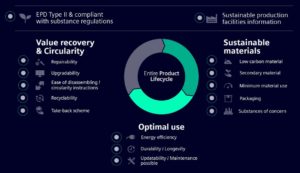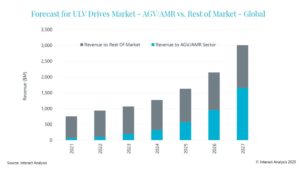ABB: Steering Through Challenging Markets
ABB announces third quarter highlights.
“Our Q3 results reflect the challenging markets we face. Short-cycle demand in oil and gas, China and the US was down and the orders compare to a strong Q3 2014 when we won a record amount of large orders in Power Systems and Process Automation,” said CEO Ulrich Spiesshofer. “However, building on our Next Level strategy, we were able to win key customer orders and to deliver margin accretion as well as a positive book-to-bill ratio in spite of significant market headwinds,” he said. “We delivered a 50 basis point improvement in operational EBITA margin and higher operational earnings per share by building on our strong focus on execution, restructuring and cost measures as well as the Power Systems ‘step change’ program.”
“We have launched Stage 2 of our Next Level strategy aimed at accelerating ABB’s transformation,” Spiesshofer said. “Markets are expected to remain challenging well into 2016. In this environment we continue to drive “self-help” by focusing on growth opportunities in a disciplined way while mitigating the impact of market headwinds through capacity adjustments, productivity measures and cost reductions. Executing our 1,000- day white-collar productivity and ongoing restructuring programs is pivotal,” he said. “We kicked off the announced strategic portfolio review of the future Power Grids division and are on track to complete it in 2016, as previously stated.
“Overall, we will continue to drive the execution of our Next Level strategy to deliver on profitable growth and sustainable value creation in challenging markets,” he said.
Short-term outlook
Macroeconomic and geopolitical developments are signaling a mixed picture with continued uncertainty. Some macroeconomic signs in the US remain positive and growth in China is expected to continue, although at a slower pace than in 2014. The market remains impacted by modest growth in Europe and geopolitical tensions in various parts of the world. Current oil prices and foreign exchange translation effects are expected to continue to influence the company’s results.
Q3 2015 Group Results
Market overview
Demand in ABB’s three major customer sectors was softer than in the second quarter, reflecting ongoing macro uncertainties and challenges in many markets. Utilities remained cautious but continued to make selective investments in infrastructure-critical power transmission projects. For example, ABB won a large order for a high-voltage direct current (HVDC) interconnection between the power grids of the United Kingdom and Norway, to increase power supply for both countries and support the integration of more renewable wind and hydroelectric energy into their networks. In addition, ABB won orders in China to boost power capacity and grid reliability. This included two new UHVDC power transmission links that are designed to transport 8,000 megawatts each of wind and thermal power from Shanxi to Nanjing and from Jiuquan to Hunan, to meet the electricity needs of 26 million consumers.
Demand from industrial customers was subdued. Low oil prices resulted in a continued restraint of discretionary spending by oil and gas customers in the quarter. However, the need for cutting edge solutions to increase efficiency and to use renewable power generation to lower the environmental impact continued to be important demand drivers. In this context, the company won a $90- million order for a high-voltage cable system to supply power from the Norwegian power grid to the Johan Sverdrup offshore oil field. Supplying electric power from shore for offshore oil and gas production avoids the need for offshore resources and to burn diesel or gas out at sea to power the equipment, which is much safer and more energy efficient. In addition, demand for Robotics solutions in general industry is growing as there is an increased need for automated processes and productivity. YuMi, ABB’s collaborative robot, helps meet this need and is in high demand.
The infrastructure and transportation market was mixed, with continuing strong demand from the renewable energy sector. For example, the company won a strategically significant order in the quarter from Socabelec to install a microgrid solution to boost renewable energy use in a remote community in Kenya. ABB’s stabilization system will be integrated into the existing power network and will interface with existing diesel power station controls, to maximize renewable energy penetration and utilize excess wind energy generated.
Orders
Total orders received in the quarter were 12 percent lower on a like-for-like basis (22 percent in US dollars) compared with the third quarter of 2014 in which the Group won a record amount of large orders in its Power Systems and Process Automation divisions. The higher US dollar versus the prior year period resulted in a negative translation impact on reported orders of 10 percent.
The order backlog at the end of September 2015 amounted to $25,371 million, an increase of 4 percent (down 6 percent in US dollars) compared with the end of the same quarter in 2014.
Base orders (below $15 million) decreased 3 percent (14 percent in US dollars) compared with a strong third quarter of 2014. Base orders were steady in Process Automation while declining in the remaining divisions. Large orders ($15 million and above) decreased 38 percent (46 percent in US dollars) compared with the same quarter of 2014 when ABB won numerous large orders. In Low Voltage Products and Power Products large orders were higher compared with the same quarter last year, while they were lower in the other divisions. Large orders represented 17 percent of total orders compared with 25 percent in the same quarter a year ago reflecting the continued cautious ordering pattern of key customer segments.
Despite double-digit order growth in countries such as Germany and Norway, overall orders declined in Europe. For the Americas and Asia, Middle East & Africa (AMEA) total orders decreased by 1 percent and 18 percent respectively even though total orders were up in the United States, China and India.
Service orders declined 4 percent (17 percent in US dollars) compared with the third quarter last year and represented 16 percent of total orders compared with 15 percent a year ago.
The book-to-bill2 ratio in the third quarter remained positive at 1.03x compared with 1.14x in the same quarter a year earlier. For the first nine months, book-to-bill remained positive at 1.07x and was above 1.0x in all divisions.
Revenues
Revenues in the third quarter declined 2 percent on a like-for-like basis (13 percent in US dollars). Revenues increased in Power Products and Power Systems due to strong execution of the order backlog. Revenues in the other divisions declined, primarily due to a lack of short-cycle volumes and weak demand in many parts of the distribution channels in the first nine months of 2015. The higher US dollar versus the prior year period resulted in a negative currency translation impact on revenues of 10 percent; 2014 divestitures had a negative impact of 1 percent.
Total service revenues increased 5 percent (down 11 percent in US dollars) and were 16 percent of total revenues.
Operational EBITA
Operational EBITA declined 1 percent on a like-for-like basis (9 percent in US dollars), reflecting the lower revenue base. Currency translation negatively impacted operational EBITA by approximately 8 percent.
The operational EBITA margin increased 50 basis points to 12.5 percent, led by the turnaround in Power Systems and ongoing restructuring and cost savings measures. The increased profitability in Low Voltage Products reflects a strong focus on cost savings and execution. The operational EBITA margin in Discrete Automation and Motion decreased principally due to a decline in the share of higher-margin standard products and services in total revenues, mainly resulting from weaker demand in the oil and gas sector in recent quarters. Process Automation was negatively impacted by reduced short-cycle discretionary spend for oil and gas. In Power Products, the operational EBITA margin was steady, as higher revenues offset unfavorable mix effects and ramp-up costs associated with new production facilities in key markets.
Operational EPS and net income
Operational EPS2 on a constant currency basis was at $0.35, increasing 2 percent5. Basic earnings per share amounted to $0.26 in the third quarter compared with $0.32 in the same quarter a year earlier. Net income for the quarter decreased 21 percent to $577 million and was negatively impacted by significant currency translation effects. In the same quarter in 2014, net income was positively affected by an after-tax gain from the sale of businesses of $145 million.
Cash flow
ABB reported steady cash flow from operating activities of $1,173 million in the third quarter compared with $1,169 million in the same quarter of 2014. The impact of the lower net income was offset by stronger working capital management.
Stage 2 of Next Level strategy
ABB launched Stage 2 of its Next Level strategy in September 2015 to accelerate ABB’s transformation. Stage 2 comprises a significant set of actions to drive the shift of our center of gravity toward higher growth, greater competitiveness and lower risk while initiating additional and accelerating existing execution improvement projects. Implementation of Stage 2 of the Next Level strategy continues along the three focus areas profitable growth, relentless execution and business-led collaboration.
Profitable growth
In line with the shift in the company’s center of gravity, ABB is realigning its divisional structure to unlock additional value by structuring the divisions more strongly according to customer needs. As of January 1, 2016, ABB will operate in a streamlined set-up of four divisions. The new Power Grids division will focus on the changing needs of utility customers with ABB’s complete power and automation offering for transmission and distribution delivered from a single source—“power & automation for the grid”. ABB’s leading offering to industry and transport & infrastructure—“power & automation for the site”—will be provided by three divisions. The new Electrification Products division will combine ABB’s leading low- and medium-voltage businesses. The Discrete Automation and Motion and Process Automation divisions will be further aligned, better addressing customer needs and delivering operational efficiency.
A strategic portfolio review of the Power Grids division was initiated and is well on track to be completed in 2016.
Organic growth remains the key focus of ABB’s efforts to accelerate sustainable value creation and is driven through the framework of penetration, innovation and expansion (PIE).
In the third quarter of 2015, ABB continued to drive growth through increased market penetration in targeted geographic and industry segments. For example, ABB supported India’s power infrastructure development by providing plant electrification, automation and substation solutions for solar power plants. The company has delivered several projects in India to become the first company in the country to deliver solar inverter solutions with a cumulative capacity of two gigawatts, or half of the overall installed base of four gigawatts in India.
Innovation continued to be a focus for growth and the company introduced several new offerings, including the innovative and successful collaboration with Dutch weather forecasting specialist, Meteo Group, to equip 140 container vessels with advisory software to optimize routes helping them to drive vessel efficiency and avoid conditions that could be harmful to the ship and its cargo or compromise energy efficiency and route schedules. ABB also commissioned the world’s first high- and medium-voltage switchgear installation for Swiss utility EWZ with a new eco-efficient gas that significantly lowers the environmental impact by offering an alternative gas mixture to the conventional sulfur hexafluoride. The global warming potential (GWP) of the new gas mixture of this solution is almost 100 percent lower than the GWP of sulfur hexafluoride.
Expansion into new high-growth markets is another driver of profitable growth. ABB and Microsoft Corp. announced the worldwide availability of a new electric vehicle (EV) fast-charging services platform. Combining ABB’s leading EV charging stations with Microsoft’s Azure cloud-based services will ensure stability, global scalability and advanced management features for ABB customers. The collaboration will also take advantage of machine learning and predictive analytic capabilities to drive future innovations. In addition, the company expanded its Asian manufacturing footprint in the quarter with a new switchgear unit in Indonesia. The medium-voltage air-insulated switchgear (AIS) will facilitate efficient and reliable power distribution and help address the increasing demand for electricity, which is driven by population growth, the need to power up many more islands and a growing industrial sector in the country.
Relentless execution
In Stage 2 of the Next Level strategy, ABB aims to close the gap in its operating performance compared with its best-in-class peers. The goal is to further transform toward a leading operating model with business processes more focused on customer needs, and an enhanced performance management system, including compensation tied more closely to performance, as well as the development of a world class people and true performance culture. This is being supported through focused 1,000-day programs to drive white-collar productivity—becoming lean for growth—and working capital management to provide cash for growth.
ABB’s white-collar productivity program is aimed at making the company leaner, faster and more customer focused. Business functions, support functions and organizational complexity are in scope of this program. Productivity improvements include the rapid expansion of regional shared services and the streamlining of global operations and head office functions, with business units moving closer to key markets. The company aims to achieve cost savings at a run rate of $1 billion a year by the end of 2017, in addition to the ongoing program to reduce costs equivalent to 3-5 percent of cost of sales each year. The work streams are on track and the consultation process with employee representatives has started.
With regard to the working capital program, the first priority is to step up efforts to improve inventory management through the entire value chain, from product design through manufacturing and logistics. Measures are being taken to reduce unbilled receivables in large projects. The company’s ambition is to increase the number of inventory turns in line with industry benchmarks. The program is expected to free up at least $2 billion in cash by the end of 2017.
Business-led collaboration
ABB continued to drive its transformation, which is aimed at improving customer focus and increasing agility to support the achievement of its 2015-2020 targets. The streamlined organization with a realigned divisional structure is ready to commence operation in January 2016. In order to drive sales productivity and collaboration across the Group, Salesforce.com was rolled out further as a common sales platform and is now operational in 14 countries. The Group Account Management team has a focused customer approach and initial pilots show proof of success.
Updated 2015-20 financial targets
In September 2015, the company aligned its 2015-2020 revenue growth target with reduced macroeconomic expectations while keeping its ambition relative to the market. The average annual revenue growth rate target over the period from 2015 to 2020 is now 3-6 percent6 (previously 4-7 percent). The driving factors for this change include the expected continuation of lower oil prices, signs of slowing industrial production growth and forecasted emerging market growth below the levels projected in 2014. All other targets are confirmed.
Management changes
ABB announced the following changes to the Executive Committee effective January 1, 2016:
Claudio Facchin, currently President of the Power Systems division, will assume responsibility for the new Power Grids division. Tarak Mehta, currently President of the Low Voltage Products division, will assume responsibility for the new Electrification Products division. Bernhard Jucker, currently President of the Power Products division, will assume new responsibilities as President of the Europe region and chairman of the newly-created Divisional Transformation Team. Veli-Matti Reinikkala, currently President of the Europe region, will retire after 22 years with the company.
Shareholder returns
ABB announced a $4 billion share buyback program in September 2014 in line with the Next Level strategy to accelerate sustainable value creation. During the third quarter of 2015, ABB purchased 4.9 million shares under the program with a buyback value of approximately $95 million. Since the program was announced, the company has purchased a total of approximately 80 million shares with a buyback value of approximately $1.8 billion.
Outlook
Macroeconomic and geopolitical developments are signaling a mixed picture with continued uncertainty. Some macroeconomic signals in the US remain positive and growth in China is expected to continue, although at a slower pace than in 2014. The market remains impacted by modest growth in Europe and geopolitical tensions in various parts of the world. Current oil prices and foreign exchange translation effects are expected to continue to influence the company’s results.
The long-term demand outlook in ABB’s three major customer sectors—utilities, industry, and transport & infrastructure—remains positive. Key drivers are the big shift in the electricity value chain, industrial productivity improvements through the internet of things, services and people and Industry 4.0, as well as rapid urbanization and the need for energy efficiency in transport and infrastructure.
ABB is well positioned to tap these opportunities for long-term profitable growth with its strong market presence, broad geographic and business scope, technology leadership and financial strength.
Discrete Automation and Motion:
Total orders declined in the quarter due to lower demand for standard products and services such as large motors and drives used in the process industries in key markets such as the US and China. Continued investments in automation for general industries continue to drive growth in robotics. Revenues reflect the lower short cycle business which could not be compensated by executing the strong order backlog. The operational EBITA margin decreased mainly as a result of lower volumes in the quarter and a lower share of standard product revenues. Focused capacity adjustments and restructuring are being further ramped up and are underway.
Low Voltage Products:
Orders were steady despite the difficult market environment. Europe’s positive order development offset declines in AMEA and the Americas. In particular, product orders were softer in China, the US and Canada. Revenues were impacted by the timing of execution of the systems order backlog. The higher operational EBITA margin reflects targeted productivity measures, increased cost savings and the strong focus on execution.
Process Automation:
The significant decline in orders mainly resulted from the comparison to the very high large orders booked in Q3 2014 and lower spending in the oil and gas sector. Subdued short-cycle orders in the first nine months of 2015 translated into lower revenues. Operational EBITA and margin declined due to weaker revenues and an unfavorable mix. Capacity adjustments are underway.
Power Products:
Total orders for the quarter were steady as increased orders for power transmission projects in the US and China offset weaker demand for base orders from the industry sectors. Revenues increased during the quarter, mainly due to the successful execution of a strong order backlog. The operational EBITA margin was steady as higher revenues offset unfavorable mix effects and ramp-up costs associated with new production facilities in key markets.
Power Systems:
Orders during the quarter were lower than the third quarter of 2014 largely due to the timing of large orders, challenging macro-economic conditions and project selectivity. Revenue growth was mainly driven by steady execution of a strong order backlog. During the quarter, the company achieved two important milestones in its offshore wind business by successfully commissioning and handing over the DolWin1 project and installing DolWin beta, the world’s most powerful offshore converter station for the DolWin2 project, in the North Sea. In addition, the first phase of the North-East Agra transmission link was energized in India. Operational EBITA and the related margin increased mainly as a result of ongoing ‘step change’ measures and continued cost savings to return the division to higher and more consistent profitability.
Source: ABB Group







